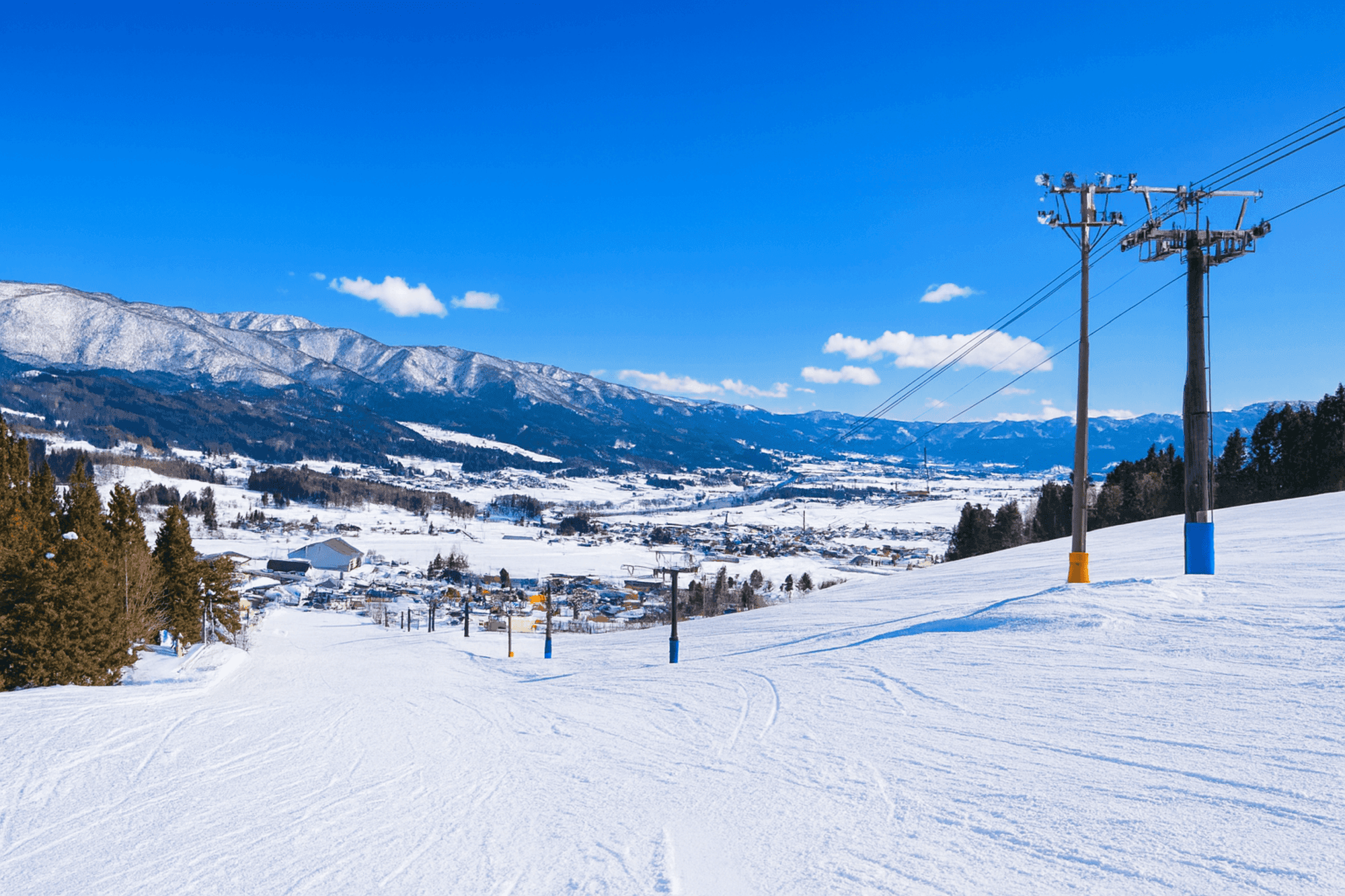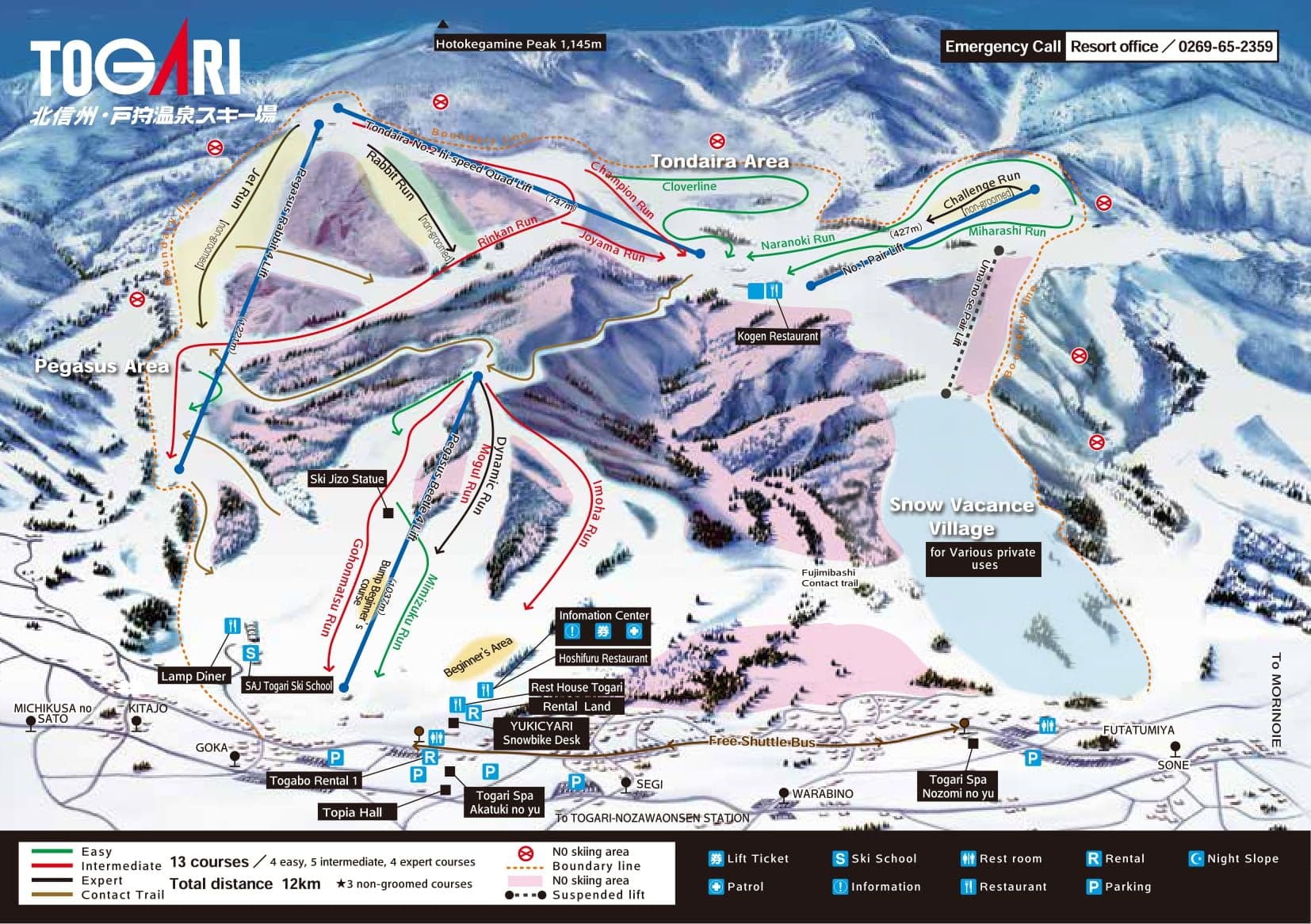Togari Onsen
Mellow lines, sneaky trees, big snowbelt

戸狩温泉
Warm cedar steam & cold smoke
Togari Onsen is the definition of easygoing Japanese ski culture: a friendly village, steaming bathhouses, and a mid-sized hill that gets far more snow than its chill vibe lets on. Sitting on the flank of the Chikuma River valley opposite Nozawa, Togari catches frequent northwest flows and serves them across open faces, rollers, and pockets of birch. It’s approachable for mixed crews and families, yet has enough off-piste flavor — within marked zones — to keep pow chasers entertained when the sky resets.
This is not a mega-resort. You won’t find a gondola, and most chairs are fixed-grip. That’s okay — the pace suits the place, and lift lines are typically short on weekdays. Weekends bring local energy from Iiyama and Nagano city, but it’s rarely a scrum; plan around the mid-morning beginner bottlenecks and you’ll keep gliding. English is understood in ticketing and rental enough to get by; in village eateries it’s more point-and-smile, which is half the fun.
Affordability is a big reason Togari keeps a loyal following. Lift tickets are sane, food on the hill is classic Japanese ski fare (think katsu curry and ramen that warms your soul), and the onsen scene is the real deal. Families love the wide, sunny learning amphitheater at the main base and the easy progression onto forgiving blues. Meanwhile, pow-minded riders keep one eye on the tree-zone status boards — when they flip to “open,” the day changes gear.
The overall ease factor is high. You’ve got the Hokuriku Shinkansen into Iiyama Station and a quick bus or taxi up-valley, or a straightforward drive off the expressway. Post-ride, slide straight into hot spring water at the village baths, then dinner in a family-run izakaya where the snow walls outside the door remind you why you came. Togari isn’t loud; it’s quietly satisfying.
Resort Stats
- Vertical620m (970m → 350m)
- Snowfall~10m
- Terrain 35% 45% 20%
- Tree Riding
- Lift Pass$33
- Lifts1 quad, 7 pair
- Crowds
- Out of BoundsDesignated tree zones allowed
- Night Skiing
- Family Friendly
- Trails19
- Skiable Area~90ha
- VibeLow-key, powder-prone, local charm
Trail Map

Powder & Terrain
Togari’s snow feel is classic northern Nagano: often cold and chalky in midwinter, with overnight resets that ski boot-top to knee-deep even on “moderate” days. Storms arrive off the Sea of Japan, squeezing out frequent top-ups that hold thanks to the hill’s north to northeast aspects. When temps spike, you’ll get dust on crust on the lower benches, but step into the tree zones and wind-protected dips and the surface stays soft longer than you’d expect at this elevation.
Terrain divides neatly across two main faces. From the main base, broad groomers roll down a natural amphitheater that’s perfect for carving and teaching. The fall line is honest, with side banks and micro-features to slash. Intermediates can roam far and not feel trapped — most blues link predictably, with cat tracks that rarely require skating. Advanced riders should aim upslope to the steeper pitches tucked under the upper chairs; they’re not super long, but with a reset they deliver repeatable fun, and the traffic doesn’t nuke them by 10 a.m.
Togari’s sanctioned tree areas are the wildcard. When patrol opens them (after the danger settles and hazards are filled in), you’ll find widely spaced birch leading into playful gullies — perfect for smearing turns, popping off rollers, and letting the boards run between trunks without feeling like you’re threading a no-fall zone. These zones are in-bounds; ducking ropes elsewhere is a fast way to lose your ticket. The resort posts status and closes them quickly if avy danger rises or coverage drops, so check first thing.
On storm days, the plan is simple: start on the lower chairs where wind exposure is minimal, harvest the sheltered sides of the main groomers, then migrate into the trees once ski patrol flips them. The top lifts can slow or pause in heavy spindrift; if that happens, keep lapping mid-mountain where the contouring terrain corrals snow. As the day wears on, groomers may get cruddy — look for wind buff on the edges of the open faces and inside turns under the chairlines.
Sidecountry here isn’t the free-for-all you might find elsewhere. There’s no formal gate network, and most of the sexy-looking outside lines funnel into terrain traps or private land. If you want to tour, save it for a separate day and head to the established backcountry venues around Nozawa or the Madarao–Tangram ridge with a partner, proper kit, and a plan. Togari’s sweet spot is letting you get a backcountry flavor inside the ropes, with consequences low and smiles high.
Who's it for?
Togari is ideal for riders who want the snow volume of northern Nagano without the mania of marquee names. Mixed groups work great: beginners learn quickly on the sunny base bowl, intermediates can rip long groomers with small steeps, and advanced skiers/boarders sniff powder pockets in sanctioned trees and upper pitches when it storms. If you need high alpine, trams, and huge vertical, you’ll feel terrain-limited here after a day or two — but as a low-stress, high-value powder option, it’s a gem.
Accommodation
You’ve got three viable bases. The first is Togari Onsen village itself — a cluster of minshuku and pensions within a few minutes’ walk or shuttle of the lifts. It’s classic Japanese hospitality: futons on tatami, set dinners, and the unbeatable combo of snowy streets and steaming hot springs. It’s quiet at night, which is perfect if your idea of après is onsen + early pillow time before first chair.
Option two is Nozawa Onsen over the river. If your crew wants more dining options and a broader onsen crawl, staying in Nozawa and driving or taxiing ~15 minutes to Togari works well. Think proper ryokan vibes (Ryokan-style stays with wooden tubs and multi-course dinners) or modern lodge hotels. It does book out fast in peak weeks, so plan early if that’s your base.
Third is Iiyama city, five stops of convenience rolled into one: Shinkansen station, business hotels, late-opening convenience stores, and easy morning buses/taxis. Rooms are simple, warm, and quiet, and you’ll be sipping coffee on the train platform heading home while others dig out cars. For dawn patrol types chasing a storm, the Iiyama base lets you pivot last-minute between Togari, Nozawa, and Madarao depending on wind and lift status.
Food & Après
On-mountain food is honest and hearty: steaming bowls of ramen, curry rice with that perfect post-run kick, and katsu that lands like a hug. Base cafeterias are efficient and affordable, and you’ll find crepes and coffee stands popping on weekends. Off the hill, the village is low-key but tasty — izakaya grilling local veg and river fish, noodle shops turning out bowls you’ll dream about on the chair, and soft-serve for the groms. Après is more lot beers than club night; your big moves are soaking in the onsen and then a stroll to a small bar for a highball and shared plates.
Getting There
The simplest route is the Hokuriku Shinkansen from Tokyo to Iiyama Station, then bus or taxi up to Togari Onsen — budget ~20–25 minutes once you’ve grabbed your bags. If you’re driving, exit at Toyota-Iiyama IC and follow the river up-valley; in winter you’ll absolutely want proper snow tires, and chains are smart if a cold front is nuking. Local roads can be narrow with tall snowbanks; anticipate reduced sightlines and give the plows space to work. In big dumps, set extra time — the payoff is free refills all day.
Japow Travel Tips
- Lift hours
Typically early morning to late afternoon; night skiing on select evenings over the main base. Exact times shift with daylight and events, so check on arrival. - Avalanche / backcountry reality
In-bounds tree zones are controlled and may close after new snow or wind for safety. Outside those ropes is not within resort management — don’t duck. If you want to tour, take avy gear, a partner, and choose an area set up for it. - Weather & snow patterns
Frequent northwest flow brings consistent top-ups. Wind can load leeward pockets nicely and scour ridgelines; storm plans should bias sheltered mid-mountain early, then trees. - Language & culture
Staff are kind and patient; a little Japanese goes a long way. Cash remains handy at small eateries. Respect bathhouse etiquette (rinse before you soak, no swimsuits). - Unique to Togari
Sanctioned tree areas give legit soft-snow turns without stressing your risk budget. The village onsen scene is real-deal rural Nagano — mellow, restorative, and authentic. - Nearby pairings
Stack Togari with Nozawa Onsen for steeper lines and bigger lift network, or Madarao/Tangram for celebrated gladed terrain. Weather or weekday crowds should guide your daily pick.
Verdict: low-key powder, high satisfaction
Togari Onsen is the undersold slope in a heavyweight neighborhood — and that’s precisely its charm. You get serious snow, honest terrain, and tree zones that light up on storm cycles, but without the elbows-out scrum that can come with “name” destinations. It’s the hill where you stack quality runs, soak properly, eat well, and wake up stoked to do it again — a sweet spot for riders who value feel over flash.